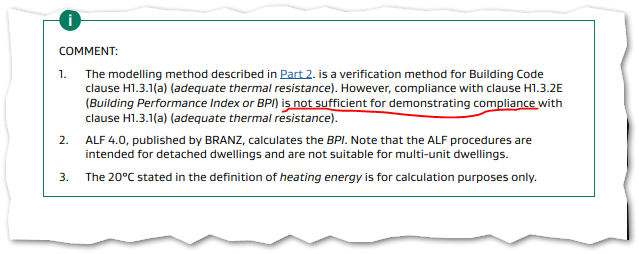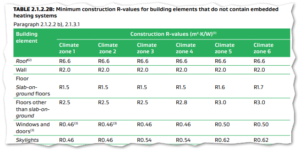Architect—and newly graduated PH designer—Murray Robertson wrote a really insightful piece about his experience designing a mass timber school building to the Passive House standard. Things were looking good: “We found for a typical mid-size school building that all that was required, apart from careful modelling and design, was better-performing windows, a relatively inexpensive airtightness layer, and a fresh air …
Loopholes in H1 changes?

To be clear folks: H1/AS1 housing changes apply to all housing, even apartment buildings of any size**. BPI (Building Performance Index) is no longer a permitted compliance method. Curtain walls are included in the R-value requirements (no change) per either H1/AS1 or H1/AS2—but need to be calculated by ISO12631. Lots of folks seem to be focused on pointing out loop-holes …
NZ “outsulation” guide now available

Now available: the Outsulation Guide for High Performance Walls, brought to you by Outright, suppliers of continuous insulation. Sustainable Engineering provided the thermal modelling calculations and I enjoyed the discussions we’ve had about applications. This guide focuses on external insulation (“outsulation”, get it?) of walls with a focus on residential applications. Download a free copy here. I’ve been asked to …
Energy efficiency will improve

Today we have it: the new H1 has been released. I no longer need to keep it all secret and can finally talk about the new energy efficiency requirements. Note there is a year’s lag before these come into effect (“adjustment period”). Just get on with it, I say to the heel-draggers. As MBIE says, “the changes go as far …
Gone in 60 mins

Wow. The scale of this Irish development is immense: 219 Passive House homes planned across a 26-acre site in Belfast, a £70m project . The first 12 houses released for sale sold in less than a hour. A further nine are about to be offered, completing the first release. These homes are expected to be completed mid-2022. We’ve one builder/developer …
Passive House homes make for happy families

Wonderful article from Stuff on the Sole Family Passivhaus in Christchurch. The Soles built a well-above-Code home about 10 years previously, but decided to go all the way on this, their forever home. Our case study has all the technical detail. Great to read that that the Soles are happy with their home, which “Nadia says is functioning ‘exactly how …
Passive House is totally achievable (and worth it)

This is a stand-out article from San Francisco Bay area Passive House builders, One Sky Homes. These guys are the real deal, coming to Passive House over a decade ago already having considerable experience in zero-energy, green builds. They now have a great deal of expertise in designing and building single family Passive House homes in California … and their …
SIP build a good PH option
“How much space do you need? Do you need a TV room, a rumpus room, a dining room, and a living room? New Zealand is an amazing country: get out of your house, get in amongst it.” That’s James Clarke talking (English builder and owner of NZSIP), and as a fellow immigrant, I have to agree. First rule of “eco-homes”: …
Ngā Kāinga Anamata announced

Kāinga Ora’s first Passive House pilot project was a great milestone but we knew far more was in the works and today we are happy to be able to share the news. Ngā Kāinga Anamata, previously known as the Five Systems Project, is five three-story apartment buildings in Glendowie, all designed to reach Passive House performance. Sustainable Engineering Ltd is …
